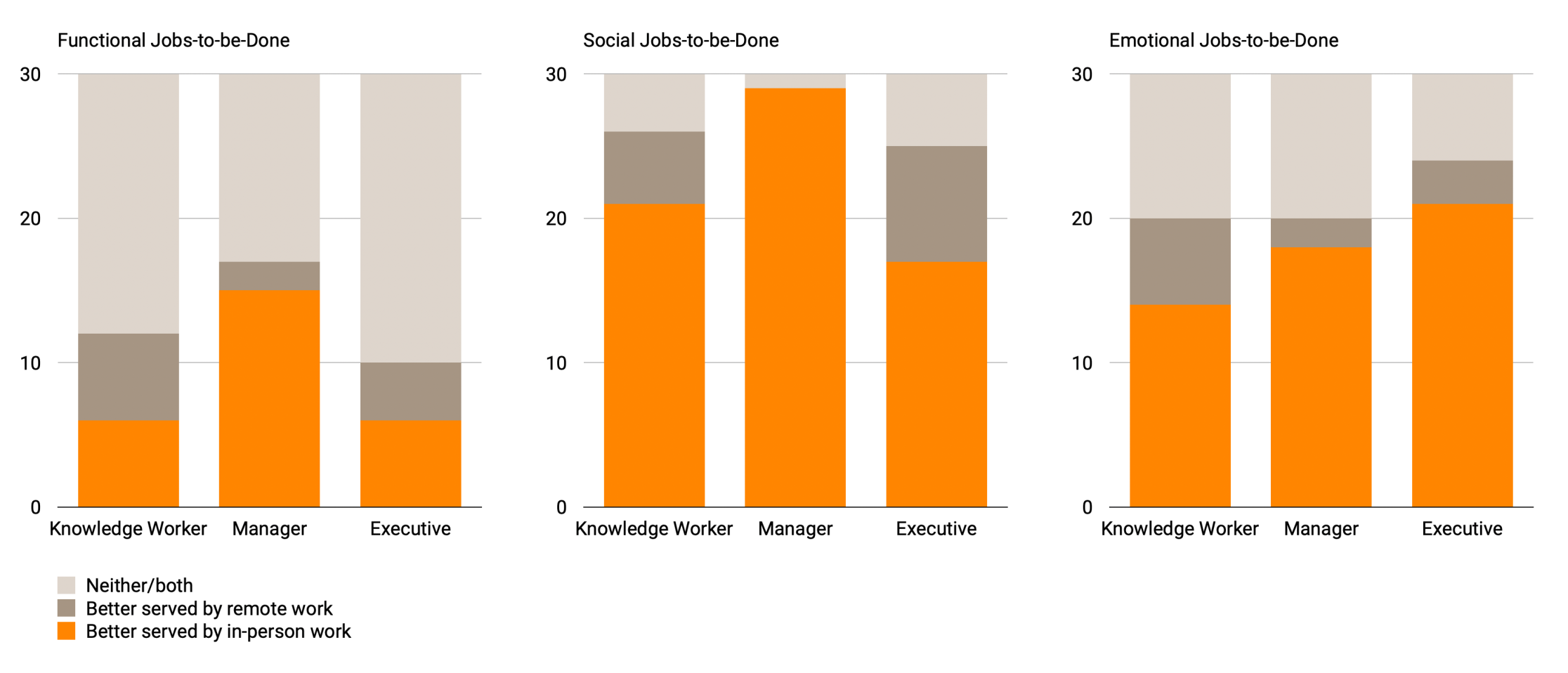We're in our return-to-office era.
So, you’re going back to the office. Let’s make it not suck.

Approximately 1.5 million office-based employees in the U.S have had new attendance policies take effect in 2023 and another 1 million are expected to face mandates before the end of the year.
Hybrid schedules continue to be king, with Tuesdays and Wednesdays driving in-person attendance…and probably even more confusion on how to operate. Whether you’re the one who made the call, the one who has to convince your team it’s better for them, or the one being pushed to come back, this is going to be a challenging time.
We all have big things we’re trying to achieve and miles-long to-do lists. So we’ve got to figure out how to make this work (hint: we can help).
For those of you thinking, “Wait. Why do I have to make this work? My current WFH situation is going just fine,” we…ran the numbers. (We couldn’t help!)
We made a list of 270 jobs-to-be-done for knowledge work, managerial work, and top executive work, split evenly across Functional Jobs, Social Jobs, and Emotional Jobs*.
*If you’re unfamiliar, the jobs-to-be-done framework crafts solutions in terms of the jobs users are trying to achieve. We use a “"When [Circumstance], I want to [job], so [need/outcome]” format for our job stories.
In doing this, we had to assume that the company in question is “good” at each one of the jobs. For example: brainstorming is usually better in-person, but there are a million ways to be bad at it!
Examples include:
Functional/Exec
- When I review feedback from investors,
- I want to address concerns and provide clarity on our direction,
- So I can maintain their trust and support.
Social/Manager
- When I participate in managerial roundtables or discussions,
- I want to voice the concerns and needs of my team,
- So I can ensure they are addressed at higher levels.
Emotional/Manager
- When I think about the balance between my professional and personal life,
- I want to have a clear boundary between the two,
- So I can give my best to both.
We categorized each job as either: Better served by in-person work; Better served by remote work; No difference.

For the folks making the donuts – audience research, crafting winning strategies, building new tools – remote work suits more of the functional use-cases.
For managers, it’s about 50-50: most of their work is about getting into things with their directs, which is much better-suited to in-person setups.
Executive functional work by nature is well-suited to remote – there are stakeholders everywhere and a good bit of the heads-down work looks similar to the knowledge workers’ day-to-day.
For the social and emotional jobs, it’s clear that being in-person is ideal – and it’s our guess that this (plus big corporate leases) is what’s driving the RTO thing. Connection. Feeling inspired by others. Having a sense that what you’re doing is good and valuable.

If RTO is a thing for you or your team, here are a few things to consider to make it less painful and, dare we say, more productive as you head back to reality.
When it comes to the people, expect lowered overall productivity and longer timelines with RTO, and know that blanket policies will turn away some of your employees for good – you have to know the costs going in.
- Don’t book meetings 9-5
- Do consider a meeting-free day in the office
- Do remember that walking between meetings takes time – the actual hallways are longer than the virtual ones – and folks need time to actually have conversations around the water cooler.
On the work, know that some work will be less efficient when done in person – and vice versa. Your team may get annoyed that their time wasn’t leveraged effectively.
For one: many execs are also on boards, working with charities, managing multiple divisions, etc. For two: check out r/overemployed for stories of folks with more than one full-time job.
- Don’t ask your team to come to the office to do heads-down work. Let them choose to use the office if it’s better for them.
- Do ask your team to come to the office for things that are truly better-served by being together: status meeting, no; packaging design review: yes.
Looking at the space and tools, it’s just true that the executives making these decisions tend to have much better working conditions than the average employee – dedicated IT personnel, better computers, someone (or many people) in charge of their calendars, maybe even a driver.
If this is you: just a reminder that working realities are different!
- Do design first for social interaction and prioritize hybrid zones over standard open office setups.
- Do critically examine how suitable your space is to the work your team is doing.
- Do grab a copy of Make Space if you want to get inspired. And check in on people’s technology. How’s it working? Is it getting in the way, or accelerating progress?
Like with all things, intentionality wins.





